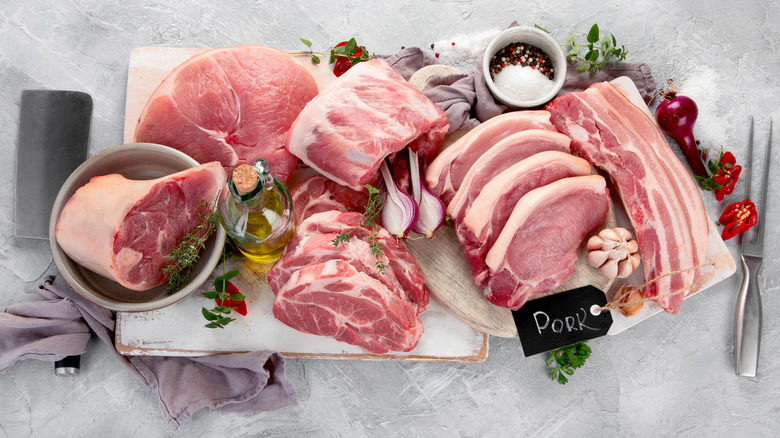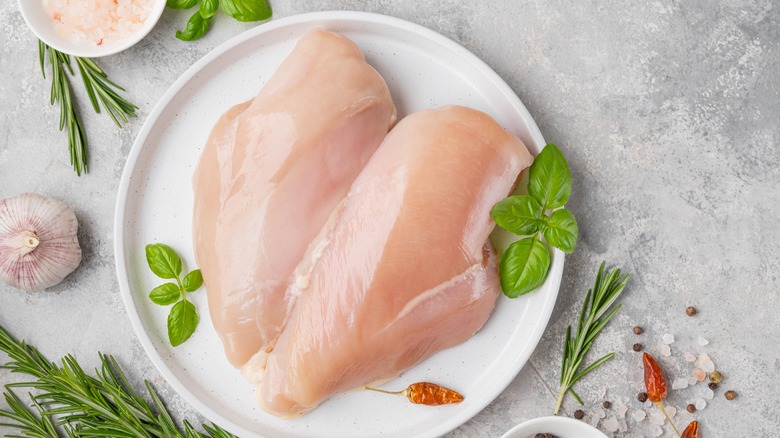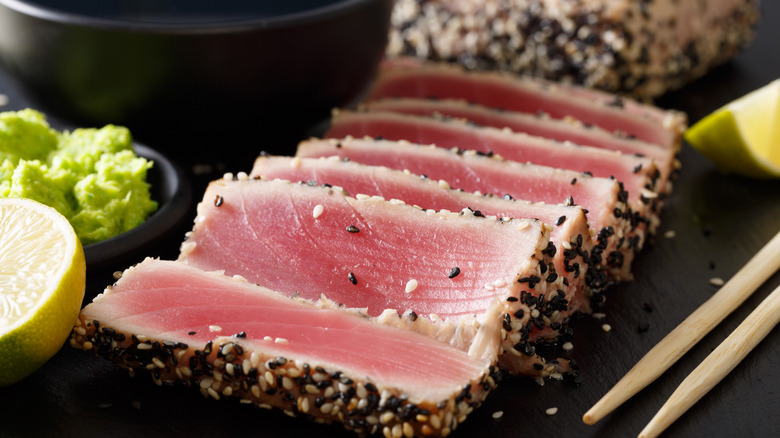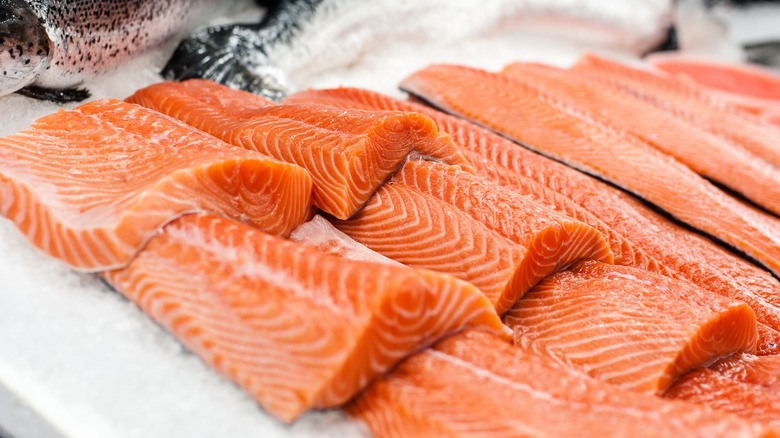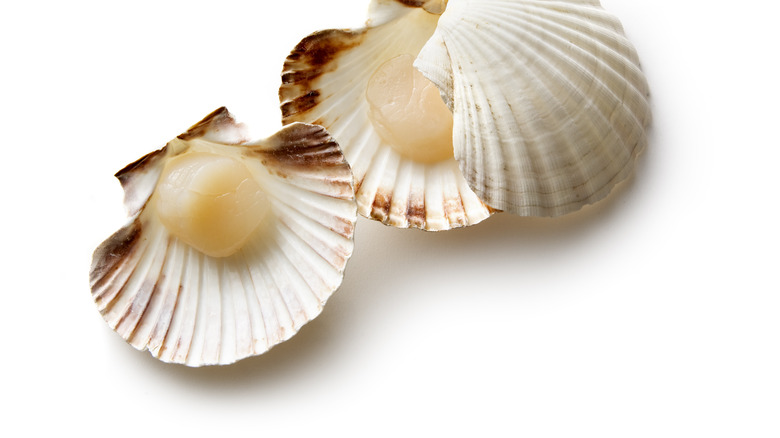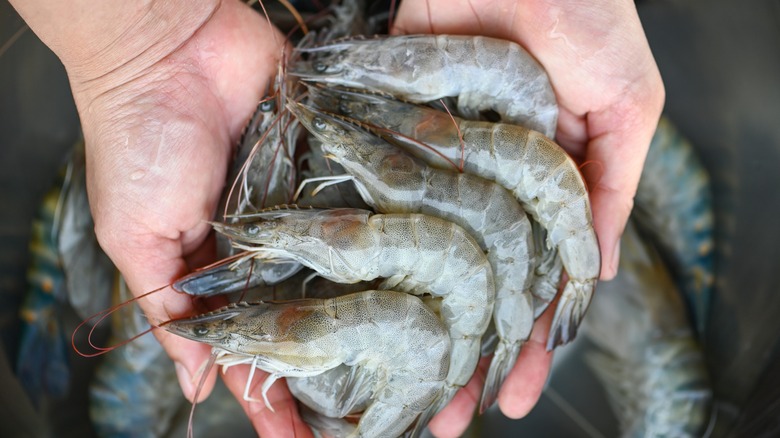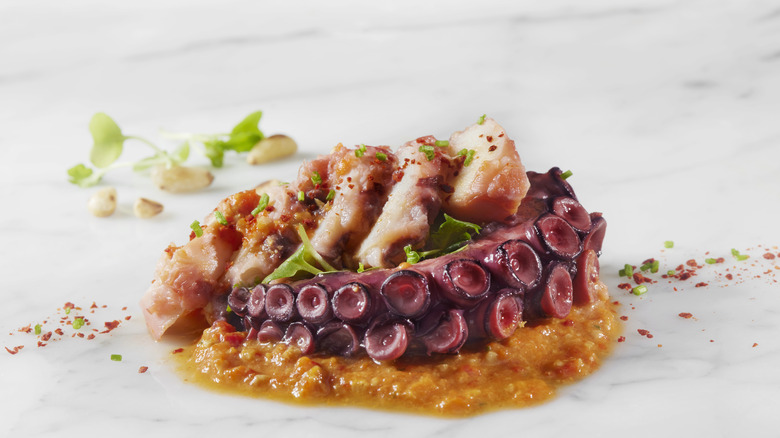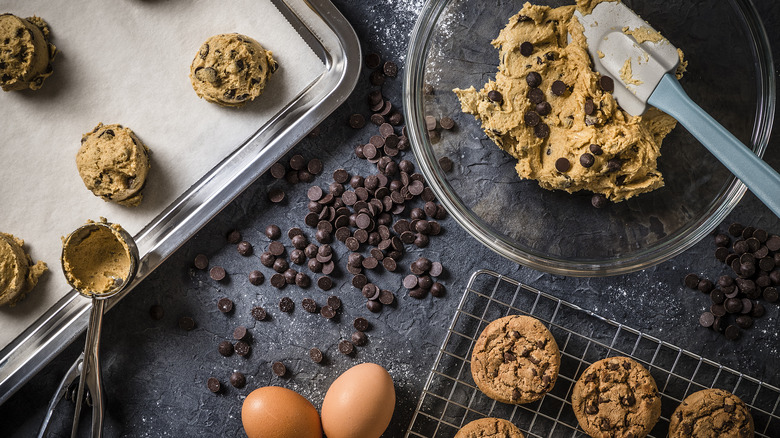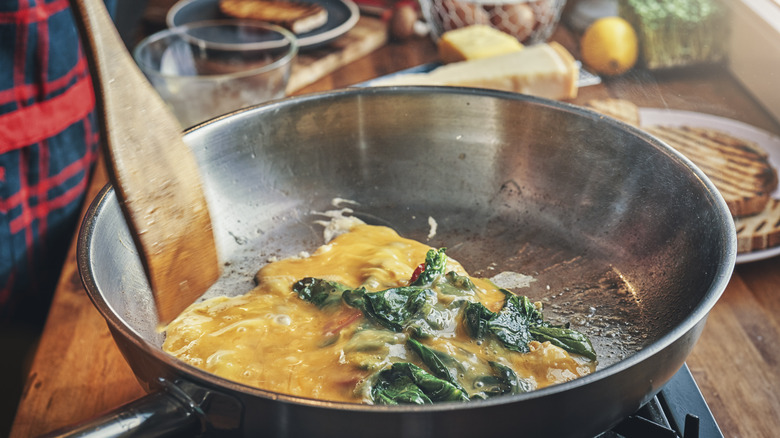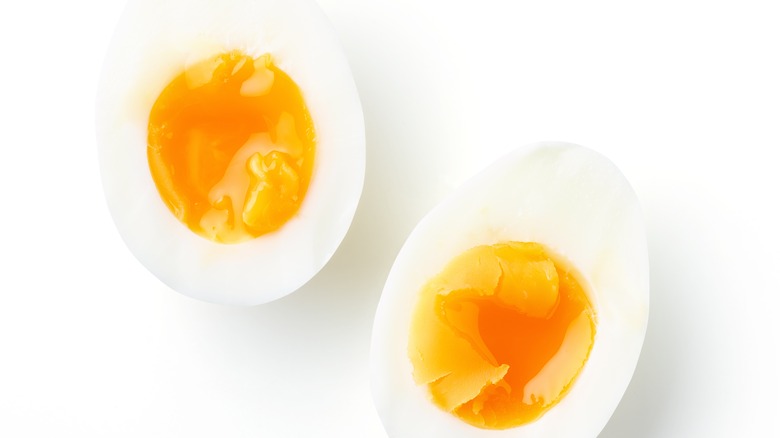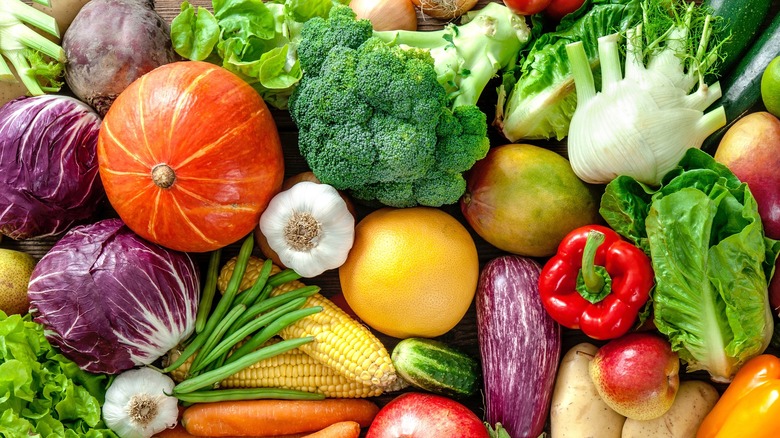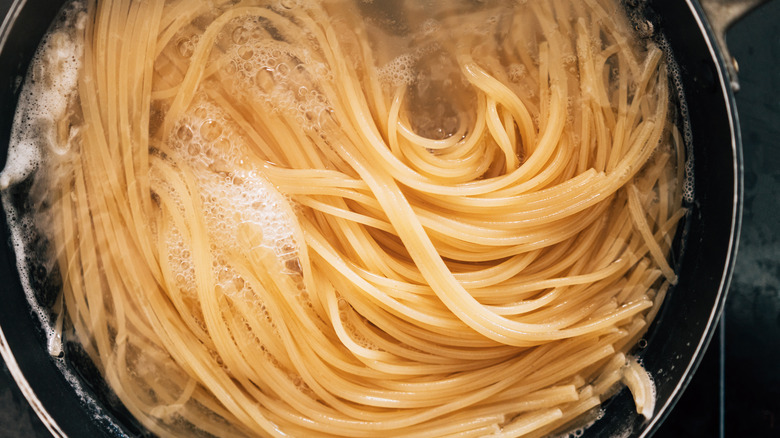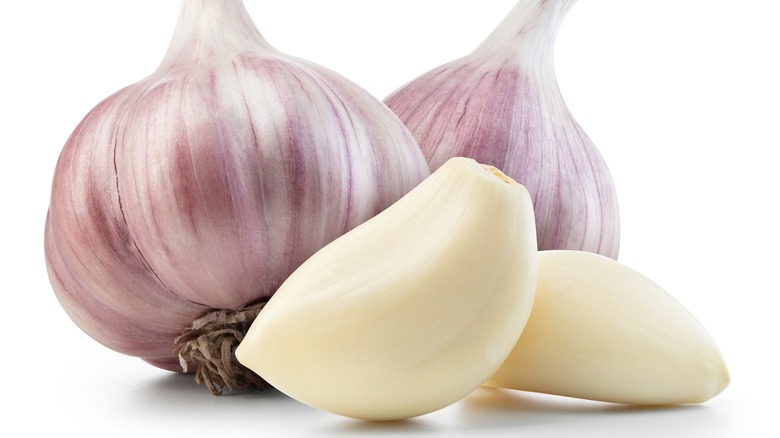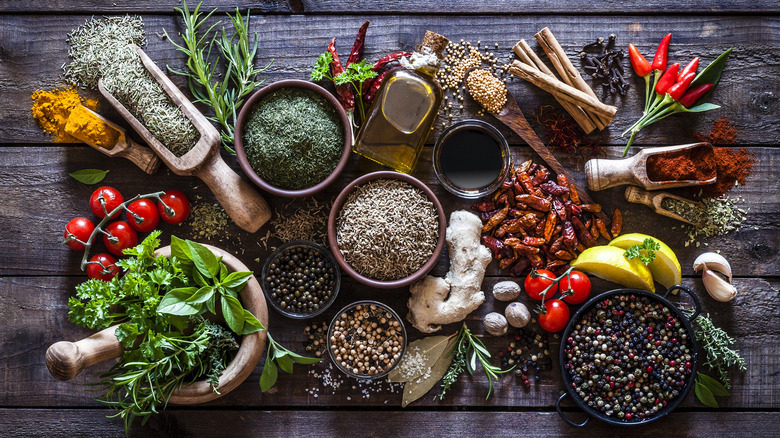14 Foods Chefs Agree Are Better Undercooked
If you've ever faced dry chicken or gray Brussels sprouts, you know the unpleasantness that is overcooked food. "Overcooking can sometimes lead to a negative perception of certain foods because it alters their taste, texture, and overall enjoyment," says Guara Pimenta, executive chef of Vela Seaport in Boston. "For instance, I don't like to roast turkey. One extra minute in the oven, and that bird will be dry as paper!"
Here at Mashed, we checked in with several experts who think it's high time the pendulum swings in the other direction. They recommend undercooking certain foods like salmon, which Josh Copeland, owner of Camino Alto in San Francisco, says can inspire a "spiritual experience" for diners when done right. But a slightly undercooked finish isn't the only goal here. Par-cooking is a technique many restaurant chefs use to save time for service — and something home cooks may take advantage of as well.
"We've all been too busy to enjoy an event," Ryan Leonard, regional executive chef for American Social Bar & Kitchen, says. "By setting up some par-cooked items, it can allow you to be present and entertain your guests! Once you get to experience that, you will catch the bug!"
1. Pork
Pork is one of the most frequently overcooked meats, according to Bobby Will, chef/owner of Thistle & Grouse in Portland, Maine. The unfortunate result — a chop about as tender and juicy as a hockey puck — has led some diners to think they don't like pork, he says. Pork has long been subject to this treatment in part because of the potential risks from Trichinella spiralis, a roundworm common in pork that causes trichinosis. But even the U.S. Department of Agriculture has changed its tune, saying that the long-time recommendation to cook pork chops to an internal temperature of 160 degrees Fahrenheit was "probably overkill," according to Consumer Reports. Instead, the USDA now recommends an internal temperature of 145 degrees Fahrenheit.
For chef Guara Pimenta, slightly undercooking pork is a no-brainer. "A medium pork tenderloin is great," he says. We're not saying you should cook pork rare, though some chefs who have access to great quality meat do. But pink pork is perfectly fine — and far juicier than white or gray.
2. Chicken
Perhaps an even better contender for "best foods to undercook" is chicken — and yet the Barefoot Contessa herself recommends just that. "Undercook it slightly, and let it rest (and keep cooking) under a sheet of aluminum foil," Ina Garten writes on Instagram. "You won't believe what a difference this makes! If you have a meat thermometer, take the chicken out when its internal temperature reaches 155 to 160 degrees."
Garten's not the only one to recommend this. "I love Ina and would trust her with my life," chef Bobby Will says. "1000% agree with her. Trust the rest." While the meat may no longer actively be over the flame, this doesn't stop the meat's center from continuing to gently heat, providing a juicy result every time. "People struggle to master the art of resting," Will says. "I purposely undercook my red meats (even chicken and fish) by 7-10 degrees so i can allow it to rest. Resting allows all of the agitated juices worked up from high heat cooking to settle back in the meat prior to slicing it."
In the case of chicken, chef Ryan Leonard says, "it can provide a juicy chicken versus poultry sawdust."
3. Tuna
According to our experts, the trophy for "most overcooked food" may well go to fish, which Chef CJ Jacobson of Aba Miami dubs "the worst offender," saying that it's so often overcooked that many diners think that's just "how it's supposed to be." And it's not — not by a long shot. "Dry and moisture-deprived fish is the worst," he says.
Tuna is one of the most frequently overcooked culprits. It's for this reason that so many chefs recommend undercooking it, searing tuna steaks so they're charred on the outside and totally rare within. "If you sear the outside of a nice piece of tuna, you can develop more flavor," Executive Chef Ian Beggs from Absinthe Brasserie & Bar in San Francisco says. "However, if you cook it all the way through you will end up with a product that reminds one more of a cheap tin of Bumblebee."
Of course, this isn't the case with all fish. "I don't recommend eating undercooked shrimp or lobster, or even swordfish for that matter," chef Bobby Will says. "Same goes for cod. But even with those fish, a gentle under cooking with allotted rest will do you well." Chef Guara Pimenta agrees, noting that he undercooks these fish and relies on carry-over cooking to finish them. "I do like to slightly undercook fish, especially halibut or cod. Proteins continue to cook when they rest, and by the time it's served it will be perfectly cooked."
4. Salmon
Salmon is another contender for most-overcooked fish, according to chef Bobby Will. "Salmon is the one fish that everyone overcooks and I hate it," he says. "Get a high quality salmon filet, sear it to medium and enjoy."
Easier said than done? Not if you take a page out of chef CJ Jacobson's book! He pre-sears skin-on fish like salmon to ensure it's always perfectly cooked — and it's a pro trick he thinks home cooks should "definitely" try out, especially because it gets "that super hot and smoky cooking out of the way" before mealtime. To try it yourself, first pre-sear the filet so it's nice and brown on the outside. Then simply place it on a rack-lined sheet tray until you're ready to finish it off. When you're nearly ready to serve, place the salmon in a 400-degree-Fahrenheit oven, and cook until it reaches an internal temperature of 125 degrees Fahrenheit so that it's perfectly cooked and moist inside.
A word of warning: The U.S. Food and Drug Administration recommends an internal temperature of 145 degrees Fahrenheit for salmon. But in opting for top quality seafood, you mitigate most risk, according to Will. "If you don't trust the quality of your salmon, tuna, or scallops to undercook them slightly, you should not trust it period," he says.
5. Scallops
If you ask chef Bobby Will, scallops are yet another seafood that gets "overcooked most of the time. ... And I hate it. Nothing worse than dry salmon or rubber scallops."
When cooking scallops, chef Ian Beggs says, the goal isn't to change their internal texture or structure. Instead, he says, "the goal is to caramelize some of their natural sugars and just barely warm them through." Requests he receives at the restaurant to cook them well-done completely negate everything that makes them so sought-after. "This will change the texture from a soft and luxurious [scallop] to rubbery ... a real shame." In fact, Beggs notes, "they are an ultra-premium product that can (and often should) be consumed raw."
Chef Ryan Leonard agrees, saying, "I find that just about anything that can be eaten raw can benefit from being cooked a little less." This holds true for other mollusks as well, such as oysters. His perfect method for cooking scallops and other seafood starts in a heavy cast-iron or cold-rolled steel pan. "Get the pan hot, add high-temperature oil, season, and sear until golden brown on one side," he says, noting that you then reduce the heat, add some butter and aromatics to season, and flip it over after a minute. "Let it hang out in the pan until it is about medium and turn it off." Residual heat does the rest.
6. Shrimp
Like scallops, shrimp can quickly go from tender and succulent to rubbery as pencil erasers ... and that holds even more true, according to chef Ryan Leonard, if they're merely one component of a recipe, as they so often are. Medium-sized shrimp cook in just three to four minutes. Even if they're perfectly cooked once they're seared, if you add them to another dish, such as shrimp pasta, they run the risk of cooking past the point of doneness and losing out in the texture department.
It's for this reason that Leonard has made a habit of undercooking any items, especially shrimp. that will be added later on in a recipe. "Sauteing the shrimp first provides an added layer of flavor to the pan," he says, "but if you were to keep them in the pan cooking while the pasta comes together, you would have a great-tasting pasta with some pretty tough shrimp." Searing them over high heat and pulling them out of the pan before they're done allows you to gently warm them toward the end of cooking, finishing them off just before serving.
7. Octopus
When properly cooked, octopus is a delight: meaty and slightly sweet with just the right amount of chew. But for chef Ian Beggs, not only is octopus frustratingly easy to overcook, but it's also one of the foods that suffers the most when it is. "Octopus is an example of a protein that when not cooked properly can be very chewy and rubbery," he says.
Luckily, there are solutions. At his restaurant, Beggs cooks octopus in an immersion circulator, aka a sous-vide machine. "The controlled temperature cooks seafood very evenly," he says, "and all liquid that is released remains in the bag with the protein, ensuring it remains very moist, even if cooked through." Once it's tender, Beggs finishes the octopus on the grill or under the broiler to sear the exterior and achieve a nice char. The result, he says, "is a tender, meaty octopus that is bursting with flavor."
8. Cookies
If you like your cookies slightly chewy, you should definitely be pulling them out of the oven slightly before you think they're done. Cookies, according to Chris Kimball of Milk Street, should be baked until the center is still quite soft, since the residual heat will continue to cook them even as they cool.
Rather than rely on the baking time dictated by your recipe, take a few visual cues from your cookies to see whether they're done. A perfect cookie should boast just the slightest sheen in the center, a surefire sign that as it cools, it will set on top but remain gooey and soft inside. Pale cookies should be slightly browned around the edges. Darker-hued cookies like chocolate cookies are easier to overbake, so keep a close eye on them to ensure you don't accidentally relegate them to dryness. As a rule of thumb, when cookies emerge from the oven, they should be almost too gooey, allowing them to set up but still remain moist once cooled.
9. Scrambled eggs and omelets
Eggs are another food that benefits from slight undercooking, and nowhere is this more true than when it comes to scrambled eggs or omelets, which chef Guara Pimenta characterizes as "the worst of all" when it comes to overcooked foods. "If you overcook an omelet," he says, "you'll basically need to throw it out and restart." Soft scrambles, on the other hand, are simply "stupendous," according to chef Josh Copeland.
As with baked goods, the secret here is to stop cooking scrambles and omelets when they're just this side of underdone. "Scrambled eggs need to come out the pan as they are just setting," says chef Chris Edwards, "as they will continue to cook on the plate even with the correct and generous amount of lard or butter they just got together with."
Once more, visual cues are your best bet to reach the ideal doneness. Scrambled eggs should look creamier and wetter than you'd personally like to eat them. Knowing exactly how underdone they should be can admittedly take some getting used to, but working over a lower heat, as Gordon Ramsay famously does with his eggs, will help reduce the margin for error. If you want to be scientific about it, break out your kitchen thermometer: Scrambled eggs are done at 160 degrees Fahrenheit.
10. Boiled or fried eggs
Scrambles and omelets aren't the only eggs that deserve to be slightly undercooked. "Eggs deserve the utmost respect and don't demand overly much cooking time," says chef Chris Edwards, who adds that the "only thing worse than a snotty undercooked white is a dry and miserable one."
When it comes to hard-boiled eggs, he says, the formula is simple. Bring a pot of water to a boil, gently add your eggs, and set a timer: After precisely eight minutes and 40 seconds, they can go straight into an ice bath. The resulting eggs will be hard-boiled with set but still-jammy yolks — perfect for use in a classic French egg mayonnaise or your favorite egg salad recipe.
Eggs don't always need to be boiled hard. "Americans need to chill out about soft eggs," chef Josh Copeland says. "The omega-3 fat in eggs does not want to be overdone." This holds just as true with boiled eggs as with fried, where, he says, a soft yolk with a bit of runniness is the perfect counterpoint to the crispy white.
11. Vegetables
This is a big category, albeit an essential one: For our chefs, most vegetables benefit from being slightly underdone. According to Ryan Leonard, undercooked vegetables have a better texture and a more vibrant color. Adds chef CJ Jacobson: "I think vegetables are the most overcooked food there is. I hated cauliflower and broccoli until I had it cooked properly." Some of his favorite vegetables to undercook are summer squashes. "They are very delicate with heat, and a little goes a long way," he says. "A nicely grilled zucchini can be tender, juicy and crisp at the same time!"
Of course, sometimes this is a matter of preference. While chef Chris Edwards notes he enjoys "a crunch most of the time," he's also noticed that a vegetable without enough give can sometimes make diners unhappy. "I have been confronted a number of times with, 'I am not a rabbit,' " he says. "If it is controlled/intentional then it is a true expression from the cook with the product in mind. Whether they are right or wrong is left to others to interpret."
In other cases, it's not just a matter of taste. Raw or undercooked vegetables may contain more levels of certain nutrients like vitamin C, making this preparation a better choice.
12. Pasta
If you've eaten pasta in Italy, you'll notice it's far more toothsome than even the most al dente pasta in the U.S. — and this holds true the farther south in Italy you go. Indeed, many Italians eat their pasta with quite a bit of bite to it, which doesn't just give it a more tasty texture — it's actually better for you. According to Simone Panella, executive chef and partner of Antica Pesa in Brooklyn, al dente pasta is far easier to digest. "Overcooked pasta tends to form a sticky dough in the digestive tract, which blocks digestion," he tells Sports Illustrated. "To digest it, the pasta must fully gelatinize the starch granules which turns the noodles into an energy drainer in your body."
The International Pasta Organisation echoes this assertion, noting that al dente pasta has a lower glycemic index, stimulating insulin production to a lesser degree and maintaining healthy, balanced blood sugar.
Even if you ultimately prefer your pasta more well done than Italians do, there's an argument for undercooking it — at least at first. If you remove undercooked pasta from the water when it's a minute or two off, you can finish cooking it in the sauce, which will lead the noodles themselves to absorb all those delicious flavors. Adding a splash of the starchy cooking water in which the pasta was cooking will only serve to thicken the sauce, making it all the more luxurious and silky when you finally serve it.
13. Garlic
When you're preparing the perfect sauce for your pasta, be sure not to overcook your garlic. "I have yet to meet a home cook that doesn't!" chef Ryan Leonard says. "And it makes all the difference in the world." Indeed, while garlic can boast a pleasant pungency when raw and be coaxed into nutty sweetness when perfectly cooked, overcooked or burned garlic, according to chef CJ Jacobson, becomes harsh and bitter, taking over the entire dish. And it doesn't take long to be pushed over the edge.
For chef Chris Edwards, in many cases, garlic barely needs to be cooked at all. When making a gratin dauphinois, for example, he rubs a whole peeled garlic into the cocotte "until it disappears," allowing the "subtle perfume" to dissipate as the gratin cooks. He also adds crushed raw garlic, salt, and parsley to hot, buttered new potatoes "only a few seconds before being served, cooking it yes, but so it retains its glorious potency."
If you are going to cook garlic, chef Bobby Will suggests erring on the side of low and slow. "Don't rush it," he says. Chef Guara Pimenta echoes this, noting that if you're worried about overcooking your garlic, you could always transform it into a slow-cooked garlic confit that's bursting with natural sweetness.
14. Herbs and spices
Toasting spices before integrating them into a dish can help bring out their natural flavors, but it's easy to overcook them. "At Ema and Aba, we use a lot of spice blends," chef CJ Jacobson says. "I can always tell if a cook has over-toasted them. It ruins the entire dish."
The same holds true for more delicate herbs, such as basil, which can oxidize when cooked for too long and lose its fresh flavor and aroma. But even hardier herbs can lose their potency with too much cooking, according to chef Chris Edwards. Rosemary "can either turn bitter or fade away if added too early," he says. "If a strong rosemary flavor is desired in a sauce or broth I like to add a lot of fresh branches just before the end and for no longer than two minutes so the freshness and scent is present."

